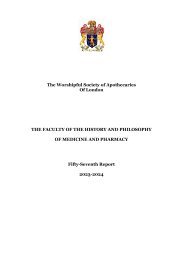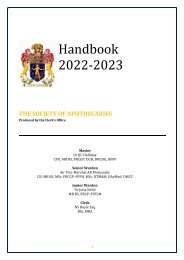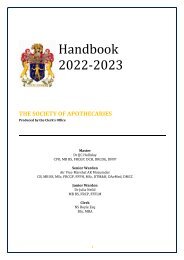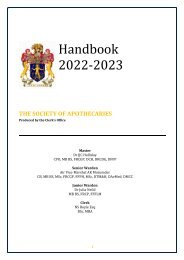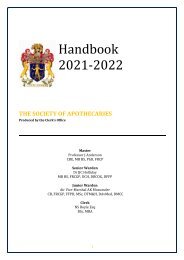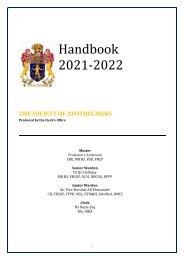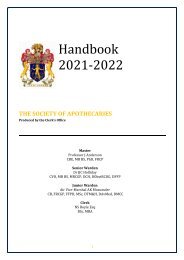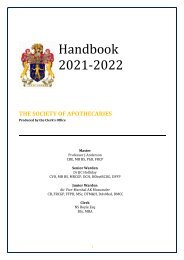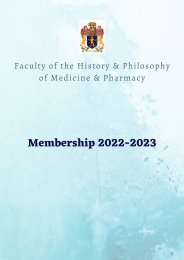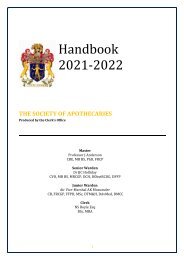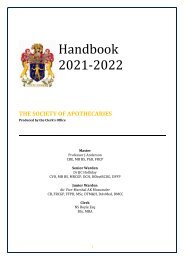Apothecary 2020
Journal of the Worshipful Society of Apothecaries for Master's Year 2019-20
Journal of the Worshipful Society of Apothecaries for Master's Year 2019-20
Create successful ePaper yourself
Turn your PDF publications into a flip-book with our unique Google optimized e-Paper software.
apothecaries and surgeons are dead of this distemper in<br />
and about the city since this visitation.” Whittet<br />
estimated between 5 and 40 per cent of the membership<br />
may have died during the epidemic. This supports<br />
Samuel Pepys' well-known diary entry from 16 October<br />
1665: “they tell me that in Westminster there is never a<br />
physitian, and but one apothecary left, all being dead.”<br />
Although Christopher Merrett claimed that<br />
apothecaries stayed in the capital because they could<br />
not afford to leave, Whittet's research into their wills<br />
showed that 17 th century apothecaries were generally<br />
wealthy men, and a number had properties in the<br />
country, so it seems that they made the conscious<br />
decision to remain in their communities. <strong>Apothecary</strong><br />
William Boghurst, based in St Giles-in-the-Fields, wrote<br />
Loimographia, An Account of the Great Plague of London in<br />
1666. He felt strongly that, if they were not putting their<br />
families at risk or were dependent on a particular<br />
physician for their livelihood, apothecaries had a duty<br />
to stay and support the sick: “those Apothecaries which<br />
stand upon their own legs, and live by their own<br />
practice, are bound by their undertakings to stay and<br />
help as in other diseases. Every man that undertakes to<br />
bee of a profession or takes upon him any office must<br />
take all parts of it, the good and the evill, the pleasure<br />
and the pain, the profit and the inconvenience<br />
altogether, and not pick and chuse.”<br />
This included continuing to contribute to the<br />
Society's activities. Although there is only one direct<br />
reference to the epidemic in the Society's Minute Books<br />
on 22 June 1665 - “In regard of the sickness this yeare it<br />
is ordered that there bee no herberisering meeting this<br />
yeare.” - the records show that Society business<br />
continued. Court meetings were held throughout 1665.<br />
Apothecaries John Battersby and Walter Pelling are<br />
mentioned numerous times in Pepys' diaries in the<br />
1660s, and Richard Lytlar, Upper Warden, Symon<br />
Williams, Renter Warden, and John Burton, the Clerk,<br />
remained in London. Michael North, elected Master in<br />
August 1665, also stayed in the capital, taking office in<br />
1666. William Garnett, the Beadle in this period, was<br />
awarded an additional £7 by the Court “in regard of his<br />
long sickness and povertie in the Contagion.”<br />
Whittet found conclusive proof that around 50<br />
apothecaries or members of their immediate families<br />
died during the plague, with an inevitable impact on<br />
Society membership. For example, on 26 May 1666 111<br />
people were called to the Livery and only 25 accepted.<br />
At least 10 members of the Court and 5 former Masters<br />
died during the plague, although not necessarily of the<br />
plague. These included Benjamin Bannister, Master in<br />
1663/4 who was present at Court meetings up to and<br />
including 30 May 1665, but was buried at St Stephens<br />
Walbrook on 16 January 1666. Stephen Chase, a founder<br />
member of the Society and apothecary to Charles I and<br />
Charles II, died during 1665 and his three daughters<br />
subsequently applied for relief from the Society. At the<br />
Court meeting on 22 February 1666, the son of Henry<br />
Best, apothecary to the Charterhouse, informed those<br />
present that “his father is very weake and like to dye”,<br />
and therefore would not be able to take up his role as<br />
Assistant. Best's will was proved on 18 May 1666.<br />
Our knowledge about the treatments and cures<br />
promoted for the plague come mainly from<br />
contemporary pamphlets and medicinal texts which<br />
were published in large numbers. In themselves, they<br />
show that apothecaries were actively supplying<br />
medicines for the plague such as Thomas Cock's treatise<br />
A Plain and Practical Discourse...upon Air...With cautionary<br />
rules and directions for the preservation of people in this time<br />
of sickness, which lists his remedies as available from Mr<br />
Wilkinson at the Mortar and Pestle in French Lane, and<br />
from Mr Reede at the Queen's Arms in Fan-church [sic]<br />
Street. A Brief Treatise on the Pestilence also published in<br />
1665 stated “Any may make these medicines themselves<br />
or be-speak them at their apothecaries, or may buy<br />
them ready made, at Mr John Danson's at the Sign of the<br />
Pestle and Mortar in Coleman Street or at Mr Hamnet<br />
Rigbies' at the Seven Stars in Fetter Lane.” William<br />
Boghurst, author of Loimographia, also advertised his<br />
services in the Intelligencer, for example, on 31 July 1665:<br />
“Whereas William Boghurst, <strong>Apothecary</strong> at the White<br />
Hart in St. Giles-in-the-Fields, hath administered a long<br />
time to such as have been infected with the Plague, to<br />
the number of 40, 50, or 60 patients a day, with<br />
wonderful success by God's blessing upon certain<br />
excellent medicines which he hath, as a water, a lozenge,<br />
etc. Also an Electuary Antidoate, of but 8d. the oz.<br />
price.”<br />
Historians have argued that the plague tested the<br />
medical profession's faith in classical, particularly<br />
Galenical, treatments and moved practitioners to share<br />
14



